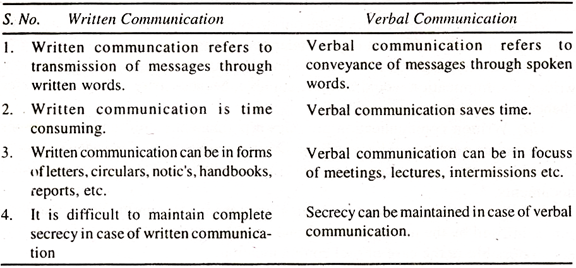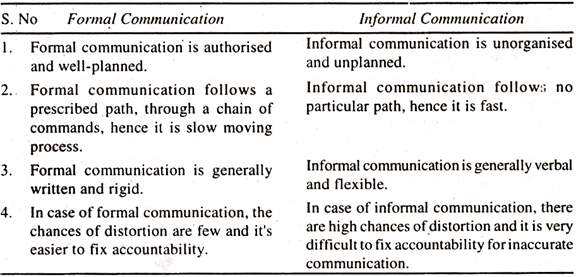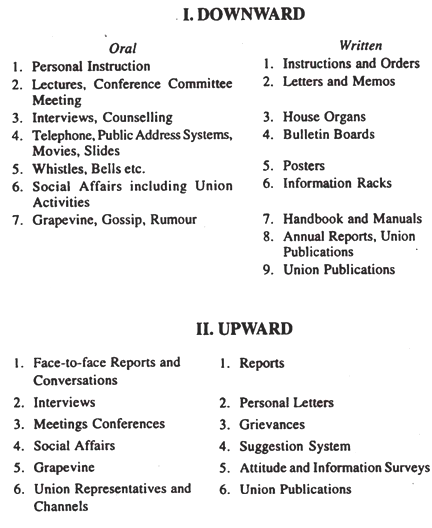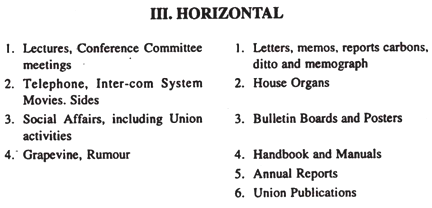Here is a compilation of essays on ‘Communication’ for class 9, 10, 11 and 12. Find paragraphs, long and short essays on ‘Communication’ especially written for school and college students.
Essay on Communication
Essay Contents:
- Essay on the Meaning of Communication
- Essay on the Definitions of Communication
- Essay on the Objectives of Communication
- Essay on the Types of Communication
- Essay on the Essential Elements of an Effective Communication
- Essay on the Principles of Communication
- Essay on the Important Barriers to Communication
- Essay on the Importance of Communication
Essay # 1. Meaning of Communication:
The word “communication” is derived from the Latin word “communis” which means “common”. When Mr. X effects a communication of his ideas with Mr. Y, he establishes a common meeting ground for understanding with Y.
ADVERTISEMENTS:
In other words, communication is an act of imparting ideas and making oneself understood by others. It is the act of inducing others to interpret an idea in the manner the speaker or the writer intends it to be done. Thus, communication literally means “sharing of ideas in common.”
In business management ideas, objectives, instructions, suggestions, etc. have to be exchanged among the managerial staff for the purpose of planning and executing the business policies.
By communication we mean to communicate things from one to the other persons. This is done to influence the other party’s thoughts, views and conduct so that the other may know, understand and act accordingly.
Essay # 2. Definitions of Communication:
ADVERTISEMENTS:
Some important definitions of communication are given follows:
i. According to Louis A. Allen, “Communication is the sum of all things one person does when he wants to create understanding in the mind of another. It involves a systematic and continuous process of telling, listening and understanding.
ii. According to Newmen and Summer, “Communication is an exchange of facts, ideas, opinion or emotion by two or more persons.”
iii. According to Ballores and Gilson, “Communication is an under course by words, letters, symbols or messages and as a way that one organisation member shares meaning and understanding with other.”
ADVERTISEMENTS:
iv. According to E. Redfield, “Communication is the broad field of human interchange of facts and opinions and not the technologies of telephone, telegraphs, radio and the like.
v. According to Ordway Tead, “Communication is a composite (a) of information given and received, (b) of a learning experience in which certain attitudes, knowledge and skills change, carrying with them alterations of behaviour, (c) of listening efforts by all involved, (d) of a sympathetic fresh examination of issues by the communicator himself, and (e) of a sensitive interaction of points of view leading to a higher level of shared understanding and common intention.”
By the analysis of the above definitions of communication, the following elements of communication are known:
i. Communication is dual, way act. i.e., it gives information from both sides.
ADVERTISEMENTS:
ii. Communication takes the help of different signs, symbols, words and pictures.
Communication pays more attention on understanding, i.e., when one understands other’s standpoints, it is completed.
Essay # 3. Objectives of Communication:
Communication fulfils the following objectives:
ADVERTISEMENTS:
i. All concerned persons should be rightly and clearly handed over the orders and instructions as that they may do work effectively.
ii. Organisation’s policies, procedures at the behaviour and explanations should be fully intimated on that at the time of difficulty and need proper authority could be approached.
iii. To convert ideas into work communication is essential. However good the idea may be it has no importance till it is communicated to the concerned.
iv. Arrange for dual-way communication so that mutual thoughts could be exchanged.
ADVERTISEMENTS:
v. Objective of communication is to propose facts and figures relating to the development and progress of the workers. On the basis of facts and figures -workers could think of their future development.
vi. This makes independent give and take of the thoughts and the information.
ADVERTISEMENTS:
Essay # 4. Types of Communication:
ADVERTISEMENTS:
i. Verbal or Written Communication:
The first important category of communication consists of verbal or written communications. In the case of verbal communication, everything is oral and there is nothing in black and white. The examples of verbal communication are orders and face-to-face discussions, telephonic talk, lectures, social gatherings, (e.g., men- boss meets), conferences, interviews, personnel counseling, public speeches, audiovisual aids like slides and movies, plant-broadcast, whistle and bells, grapevine, etc.
Some of the merits of this form of communication may be outlined as follows:
(i) It is a time and money saving device. In the case of written communication the instruction, etc. are reduced to writing. There is no need of this formality in verbal communication. There is other device which may be so short, sweet, simple and quick.
(ii) It is comparatively more effective, because there is the instinct of personal touch in verbal communication. Everything is face-to-face and there is nothing behind the screen; hence a better and immediate impression can be created particularly when the communication is accompanied by actions, gestures and charming facial expressions.
ADVERTISEMENTS:
(iii) There is easy understandability in the case of verbal communication. Even if doubts creep in the minds of the party, they can immediately be removed.
(iv) It is also more convenient to measure the effects of communication. The communicator can easily guess whether the recipient is following him or not and thus can make all possible efforts to clarify his viewpoint to the other party. He can immediately make proper amends and can discern the recipient’s attitude, whether it is one of acceptance or rejection.
In the case of written communication, immediate change is never possible, particularly when the communication has been transmitted so as to be out of the power of the communication or to withdraw.
(v) It is the only way out during periods of emergency when every activity is to be quickened. Face-to-face contact during such periods can quicken the tempo of work and increase productivity.
Verbal or oral communication is, however, not suitable demerits in the following cases:
(i) Written communication is the only way out if both the communicator and the recipient are far off, even beyond telephonic range.
ADVERTISEMENTS:
(ii) If the message to be conveyed is lengthy and needs a thorough clarification, written communication would be more suitable, because there will then be lesser chances to miss any point.
(iii) Written communication provides a permanent record and can at times be referred as evidence. This is why policy statements (e.g., Chairman’s speech, Director’s report, Service conditions, etc.) are usually issued in the form of printed documents.
(iv) Written communications have a permanent value in the sense that they can be utilised by the management off and on, when the need arises in future. It is not so possible in the case of oral communication.
(v) Last but not the least, in the case of written communications, the recipient can conveniently, ponder over the message and request for amends, if necessary. Further, subordinates can feel secure in their performance and supervisors are better equipped to exercise check on it.
On the other hand, written communications are always in black and white. Examples of written communications are house organs and newspapers, bulletin boards, letters and memos, reports and forms, manuals and handbooks. Posters, payroll inserts, annual reports, written grievances, suggestion system.
Attitude questionnaires, newspaper inserts, etc. The above disadvantages of verbal communication are in other words the merits of written communication.
ADVERTISEMENTS:
Some of its serious disadvantages may be outlined as below:
(i) In the case of written communication everything is to be translated into black and white, which is likely to consume more time and money. Face-to-face contacts may be short and quick, but written communications must be long (to achieve clarity of thought) and lucid.
(ii) It is not always possible to reduce everything to writing and if any point is left out, additional written communication may become a necessity, which is expensive and takes time.
(iii) Oral talks may remain secret, but there are chances of leakage in the case of written communication.
(iv) Delays and red-tapism are some of the other drawbacks of written communication.
Out of the two forms of communication—verbal and written—which is better, is a difficult question to decide. Indeed its answer depends upon the circumstances of each individual case. The essential problem is to provide the balance.
ADVERTISEMENTS:
A firm having an excellent bulletin board system but poor channel for upward flow can never be successful in the overall communication programme. Proper balance should be sought to provide adequate channels up down, across and outside; oral and written devices should be used as per the need of the situation and according to the content of communication.
ii. Formal or Informal Communication:
Secondly, communication may be classified as formal or informal. Formal communications are mostly in black and white. They derive their support from the formal organisational structure. Formal communications are generally associated with the particular position of the communicator and the communicate (or recipient) in that structure.
For example, when the General Manager instructs his subordinates by virtue of his superior position, it is formal communication. Informal communications, on the other hand, are free from all sorts of formalities. They are based on the informal relationship between the parties.
They are generally termed as ‘the grapevine’. Informal communications may be conveyed by a simple glance, gesture, nod, smile or mere silence. For example, if a worker approaches his boss with the job completed by him to get his approval, and the boss expresses his silent approval, it is informal communication.
ADVERTISEMENTS:
Difference between Formal and Informal Communication:
iii. Downward, Upward or Horizontal Communication:
Under the third category, communications may be classified as downward, upward or horizontal. Communication is said to be downward if it flows from the uppermost levels of management towards the operative force; it is upward, if it flows from the subordinates to their superior and it is horizontal if it takes place between two subordinates of the same superior (e.g., between two departmental heads or between two or more persons who are tied to each other by relationship of equality). All these communications—downward, upward and horizontal may be verbal or written. The following list is quite illuminating with regard to the examples of such communications.
Essay # 5. Essential Elements of an Effective Communication:
Following elements are to be maintained for effective communication:
i. Clear: Brief and Complete Statement:
To make effective communication, it is essential that communication should be short but clear so that every person could understand appropriately without wasting time. It should provide a complete statement.
ii. Courtesy:
The language of communication should be courteous, if necessary, harsh words should be used but courtesy and civility should not be left.
iii. To Present Ideal Behaviour:
One, who is giving orders as he expects from the subordinates, should follow ideal behaviour and should obey the rules himself.
iv. Mutual Cooperation:
Mutual cooperation is quite necessary for effective communication. When receiver and sender of communication are not co-operating, then it is possible that he may not get the news or catch the wrong and spread rumors.
v. Adequate Transmission Technique:
The uniform policy should be followed while sending communication from up or down. If communication technique is not proper then disputes will increase.
vi. Cordial Relations between Different Departments of Administration:
Effective communication needs necessarily good relations between different departments and persons.
vii. Continuity:
Communication process goes on forever. At present continuous process is needed as communication process is not one-way but is two-way process.
Essay # 6. Principles of Communication:
Following are some of the principles of communication:
i. Principle of Clarity:
While communicating, the news should be in clear language so that receiver should grasp it clearly as the sense of the sender was. It should not mean different.
ii. Principle of Consistency:
Policies of the concern should not go against objectives and programmes. Various information should not go against one another. Reciprocal contradicting information create illusions and the work may spoil.
iii. Principle of Attention:
It is to make know the receiver own thoughts and not to express only. This is possible only when the receiver takes interest in it.
iv. Principle of Adequacy:
Information should be enough, not incomplete which is more dangerous even than not giving information.
v. Principle of Informality:
Informal communication has also its own importance. Formal communication makes the continuity while informal communication should also be developed.
vi. Principle of Integration:
Communication means to can solidity the concern. Management should at ways remember that the communications an instrument and not the solution. Hence, they must develop the sense of integration and cooperation among personnel.
vii. Principle of Timeliness:
By this we mean that communication should be timely. Late communications have only historical importance and none else. But before communication it should be thought over with all aspects of facts of circumstances.
viii. Principle of Feedback:
Most of the communications are one-sided. Management does not consider the other side. The reactions of the other side should be cared. So feedback should be used.
Essay # 7. Important Barriers to Communication:
Some important barriers to communication are as follows:
i. Uneducated employees:
Most of the Indian workers are uneducated. They are not able to grasp the news given to them through various media. Instructions given through pictures, cannot be grasped by the workers.
ii. Difference in what is said and done:
In communication as compared to words, actions are more important. If manager attends in time, the workers also will come in time.
iii. Lack of money:
An effective communication needs money. Employer thinks expenses on communications to be a waste and even if they use, they have not enough funds, hence finance also brings difficulty in effective communication.
iv. Views of Workers and Management:
In our country workers and management are not of the view of co-operating but of opposing one another does Management not esteem the labour. On the other hand, workers are of the opinion that when management needs work to be accomplished, they are respected.
v. Fear:
Any worker hesitates to give the upward communication to the supervisor because of the fear, that it would embitter relations.
Essay # 8. Importance of Communication:
Some importance of communication are:
i. Smooth and Unrestricted Running of the Enterprise:
The smooth and unrestricted running of an enterprise depends on an effective system of communication. In every organisation, big or small, may it be in the public or private sector, communication plays a major role.
In industrial or manufacturing concerns instructions and information is passed on continuously from one end to the other, from a superior to his subordinate, from a labour officer to the workers, from the managing director to his executives and so on.
ii. Quick Decision and Implementation:
Communication helps the administration in arriving at vital decisions. In its absence, it may not be possible for the top administrators to come in closer contact with each other and discuss the important problems pertaining to the organisation.
In short, effective communication is the sine quanon for quick and systematic implementation of management decisions. It is the basis of direction and leadership. It lubricates the entire organisation and keeps the personnel working in accordance with the desires of the top administration.
iii. Proper Planning and Co-Ordination:
Communication also helps a lot in planning and co-ordination. The widest possible participation in planning is a pre-condition for getting the task done, and this can be effectively secured only through the media of communication.
Co-ordination between groups is a must for the efficient functioning of the entire enterprise. Well, to a large degree this coordination and co-operation depends upon adequate and effective system of communication at all levels of management and in all areas of organisation.
According to Mary Cushing Niles, “Good communication are essential to coordination. They are necessary upward, downward and sideways, through all the levels of authority and advice for the transmission, interpretation and adoption of policies. For the sharing of knowledge and information, and for the more subtle needs of good morale and mutual understanding.”
iv. Maximum Production at Minimum Cost:
If proper communication is arranged in an industry, owner and workers have cordial atmosphere so production will be continuous, lockout or strike will be avoided and workers will do work heartily so that different types of loss like goods, and time are not possible and maximum production is possible at minimum cost.
v. Quick Decision and Its Enforcement:
Effective communication is needful for the quick decision taking in big business of large scale as thoughts will be quickly transmitted and problems will be solved.
vi. Incentive to Democratic Feelings:
Decisions in any concern are done by a manager or director but all decisions are actuated by the workers are properly cared and promoted they will feel proud.
vii. Job Satisfaction:
The effective media of communication develops the feeling of mutual trust. Hence workers know what the management expects of them and what they are doing.



